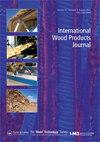Impact of different polyethylene glycol wood treatments on the adhesive properties of beech wood
IF 0.9
Q2 MATERIALS SCIENCE, PAPER & WOOD
引用次数: 1
Abstract
ABSTRACT Modified beech wood, treated with polyethylene glycol (PEG), was examined regarding its adhesive properties. Therefore, beech wood was modified with various molecular weights and amounts of PEG. All variants of the PEG treatment lead to an improved dimensional stability of beech wood samples. Afterwards, three different kinds of adhesive systems were tested on the modified wood. The three adhesive systems were based on phenol-resorcin-formaldehyde (PRF), emulsion-polymer-isocyanate (EPI) and melamine-urea-formaldehyde (MUF). The adhesives were tested according to a delamination test between layers (DIN EN 16351 annex A) and a determination of the longitudinal tensile bonding strength (DIN EN 302-1 A1). The achieved results showed an effective wood modification with suitable bonding properties. The usage of PEG-modified beech in constructive applications such as cross-laminated-timber (CLT) seems to be possible.不同聚乙二醇木材处理对山毛榉木材粘合性能的影响
摘要:研究了聚乙二醇(PEG)改性山毛榉木的粘接性能。因此,对山毛榉木进行了不同分子量和PEG用量的改性。聚乙二醇处理的所有变体都能改善山毛榉木材样品的尺寸稳定性。然后,在改性木材上测试了三种不同的胶粘剂体系。这三种胶粘剂体系分别为苯酚-间苯二酚-甲醛(PRF)、乳液-聚合物-异氰酸酯(EPI)和三聚氰胺-尿素-甲醛(MUF)。根据层间分层试验(DIN EN 16351附录a)和纵向拉伸粘结强度测定(DIN EN 302-1 A1)对粘合剂进行测试。结果表明,该改性剂具有良好的粘接性能。聚乙二醇改性山毛榉的用途在建设性的应用,如交叉层压木材(CLT)似乎是可能的。
本文章由计算机程序翻译,如有差异,请以英文原文为准。
求助全文
约1分钟内获得全文
求助全文
来源期刊

International Wood Products Journal
MATERIALS SCIENCE, PAPER & WOOD-
CiteScore
2.40
自引率
0.00%
发文量
27
 求助内容:
求助内容: 应助结果提醒方式:
应助结果提醒方式:


